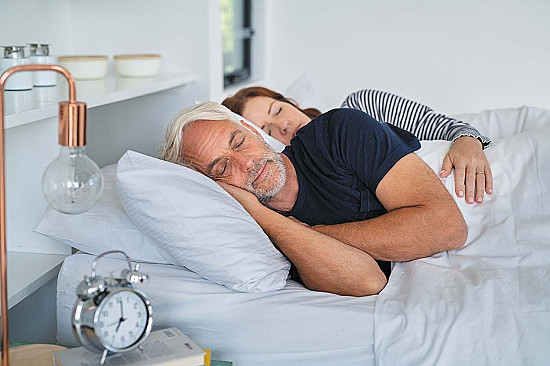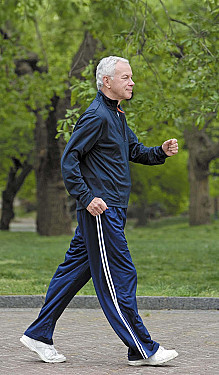Cold comfort
Winter is a great time to get outside and enjoy the exhilarating feeling of exercising in low temperatures.
- Reviewed by Howard E. LeWine, MD, Chief Medical Editor, Harvard Health Publishing; Editorial Advisory Board Member, Harvard Health Publishing

Wintertime can cause many people's active lifestyle to go into hibernation. But instead of hiding from the cold, why not embrace it?
"When temperatures dip, you can still enjoy many of your regular outside routines, like walking, running, and even cycling," says Dr. Adam Tenforde, an associate professor of sports medicine and rehabilitation at Harvard-affiliated Spaulding Rehabilitation Network.
In many ways, winter offers health benefits you don't get in summer. For instance, cold weather may improve endurance, says Dr. Tenforde. "Compared to high temperatures with humidity, in cooler temperatures, your body spends less energy on maintaining body temperature, and you don't sweat excessively, allowing you to exercise more efficiently."
Evidence also suggests that exercising in cold weather can transform some white fat, including belly fat, into calorie-burning brown fat.
Cold opportunities
Winter is also a prime time to change up your exercise routine by adopting seasonal activities or adjusting your regular ones. For example:
Fat biking. The tires on a fat bike are four to five inches wide, ideal for riding across snow and slick off-road terrain. Fat bikes are suitable for older adults, as their design keeps riders upright, reducing back strain.
Cross-country skiing. For this winter-only sport (also known as Nordic skiing), you wear skis that allow your heel to lift off the ski so you can efficiently slide your foot forward through the snow. Cross-country skiing is a low-impact sport that is generally safer than downhill skiing, and it offers a full-body workout that uses your arms, legs, core, and back muscles. Cross-country skiing also helps to improve balance and coordination.
Running, walking, and hiking. Year-round endeavors like running, walking, and hiking can benefit from northern exposure. For instance, you can experience new perspectives of your usual routes or explore new trails in national parks. Winter hiking and walking also encourage the use of trekking poles, which not only protect against falls but increase the intensity of workouts by engaging the arms, shoulders, and core.
Beating the wintertime bluesAnother advantage to outdoor winter exercise is that it helps with seasonal affective disorder (SAD), a type of depression that typically emerges during the late fall and early winter and often ends by spring or early summer. The exact cause of SAD is unknown, but research points to lack of light as the main contributor. How does SAD occur? Sunlight exposure stimulates the hypothalamus, a part of the brain that helps control your circadian rhythm — the body's internal 24-hour sleep-wake clock. Lack of light can throw off your circadian rhythm. This can cause your brain to produce too much of the sleep hormone melatonin and to release less serotonin, a brain chemical that boosts mood. The result of this chemical imbalance? You feel low and lethargic. Other common symptoms of SAD include lack of sexual energy, overeating (especially from craving high-carbohydrate and high-calorie comfort food), and social withdrawal. |
Cold-weather tips
While cold-weather exercise is safe for most people, if you have certain conditions, such as asthma, heart problems, or balance issues, check with your doctor before exercising outdoors in the cold. And in any case, make sure you dress properly to protect yourself from chilly temperatures. Here are a few strategies to follow.
Bundle up. Dress in layers so you can be comfortable without getting overheated. Dress for a temperature about 10° higher than the day's forecast, as you'll generate heat as you move. Try this three-step layering system:
1. Start with a light, wicking fabric closest to your skin like CoolMax or polypropylene. It pulls sweat away from your skin and allow it to dry quickly.
2. For your insulation layer, look for a fleece, sweater, or sweatshirt made of a synthetic fabric like Polartec or a wool blend that provides warmth while wicking away moisture. (Avoid cotton because it will stay wet from sweating and cause a chill.)
3. Use a waterproof or water-resistant breathable jacket and pants, such as those made of Gore-Tex. Velcro or drawstrings at your waist and wrists will also prevent cold air from sneaking in.
Protect head, hands, and feet. In cold temperatures, blood flow concentrates in your body's core to help keep you warm, which leaves your head, hands, and feet vulnerable. Wear gloves lined with wool or fleece, or add a thin pair of glove liners made of a wicking material under a pair of heavier gloves. Also, wear heavy socks and a wool cap that covers your ears, and protect your eyes from wind and glare with wraparound sunglasses.
Watch the sun. Sunburn is a year-round threat, and your risk rises when you're surrounded by snow, which reflects sunlight. Use sunscreen with a minimum 30 SPF that blocks UVA and UVB ultraviolet rays. Apply generous amounts to your face, neck, ears, and hands. Use an SPF lip balm to protect against sunburn and wind-chapped lips.
Stay hydrated. While you may not need the same fluid intake as during summer, you still need to maintain the same approach to hydration. "Drink water before, during, and after your activity," says Dr. Tenforde. Cold air often suppresses thirst, so consider setting a timer on your phone or fitness tracker to remind you to drink every 15 to 30 minutes.
Watch the weather. A good rule of thumb: skip outdoor adventures when temperatures drop below 32° F (the freezing point). Freezing temperatures can increase your risks for hypothermia and falling on frozen surfaces.
Image: © Jeremy Poland/Getty Images
About the Author

Matthew Solan, Executive Editor, Harvard Men's Health Watch
About the Reviewer

Howard E. LeWine, MD, Chief Medical Editor, Harvard Health Publishing; Editorial Advisory Board Member, Harvard Health Publishing
Disclaimer:
As a service to our readers, Harvard Health Publishing provides access to our library of archived content. Please note the date of last review or update on all articles.
No content on this site, regardless of date, should ever be used as a substitute for direct medical advice from your doctor or other qualified clinician.















